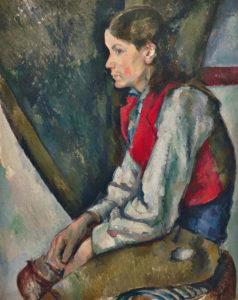R657 – Le Garçon au gilet rouge, 1888-1890 (FWN495)
Pavel Machotka
(Cliquer sur l’image pour l’agrandir)
Dans la version du Garçon au gilet rouge dans laquelle on voit le profil gauche du modèle, le visage est traité plus légèrement avec une dominante de jaune, mais ceci se justifie techniquement : il faut laisser la tête ressortir afin de souligner le profil. En fait, le contour net et son contraste avec le rideau presque noir font de ce profil le plus incisif de l’œuvre de Cézanne, et l’on imagine que Cézanne a demandé à son modèle de poser provisoirement assis de côté, pour pouvoir rechercher des résonances entre le profil et le reste du tableau ; il voyait l’arête du nez faire écho à la courbe du dos, son plat redoublé par le devant du gilet et par le bras, et le peintre savait qu’il pouvait en tirer le meilleur parti. On peut supposer qu’il avait donc arrangé le rideau pour qu’il confirme ces rythmes (il ne tombe pas naturellement), parce que chaque ligne du profil, à l’exception du front et de la lèvre supérieure, reflète soit le bord droit du Rideau, soit son bord gauche. En regardant le tableau, après avoir remarqué cette unité discrète, on sera peut-être alerté par les touches qui redoublent le bord gauche du rideau, y compris dans la manche magnifiquement articulée. Pour un tableau qui a pris le risque d’imposer une présence si intense du rouge et d’un contraste si violent entre le visage et le fond, il est remarquablement unifié et harmonisé.
___________
In the version in which the model is seen from left profile (R657), the face remains lighter and yellower, but this, too, has a technical justification: the head must be allowed to stand out in order to emphasize the profile. In fact, the clear outline and its contrast with the near-black curtain, make this the most incised profile in Cézanne’s work, and we may imagine Cézanne asking the model to pose tentatively from the side so that he can look for resonances between the profile and the rest; he would see the bridge of the nose echoed in the curve of the back, and the slope of the nose doubled by the vest front and the upper arm, and be assured of the needed resonances for the composition. We may suppose that he would have then arranged the curtain to confirm these rhythms (it does not hang naturally), because every line of the profile, except for the forehead and the upper lip, now reflects either the right edge of the curtain or the left one. As we look at the painting, having noticed this unostentatious unity, we may be alerted to the touches, which double the left edge of the curtain even in the beautifully articulated sleeve. For a painting that risked so strong a presence of red and so violent a contrast between the face and its background, this one is splendidly unified and resolved.
Source: Machotka, Cézanne: the Eye and the Mind.
Voir aussi Le Garçon au gilet rouge, 1888-1890 (R657-FWN494)


